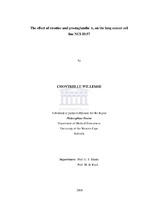| dc.description.abstract | Lung cancer is the most common fatal cancer in terms of both incidence and mortality in the world. The most important cause of lung cancer is exposure to
tobacco smoke through active or passive smoking. Nicotine which is a major
component of tobacco could be assumed to be a tumour promoter since it had been
indicated to stimulate tumour growth. Over expression of Bcl-2 in human lung
cancer cells blocked the induction pathways (type I and II) of apoptosis. The
increase in Bcl-2 in patients with lung cancer had also been linked to nicotine. In
recent years nicotine replacement therapy has become a therapeutic method to treat smoker’s withdrawal symptoms and to advise cancer patients to stop smoking
because, numerous cancer patients continue to smoke after their diagnosis. Non
small cell lung carcinomas constitutes for approximately 80% of lung cancer cases.
However, even with the development and improvement in conventional treatments
of surgery, radiation and chemotherapy, the 5 year survival rate for these patients
remains less than 15%. Chemoprevention, an approach to control cancer, is the use
of specific natural or synthetic substances with the objective of delaying, reversing,
suppressing or preventing carcinogenic progression to invasive cancer. A promising
tool for chemoprevention against lung cancer could be prostaglandin A2 (PGA2),
since it had been shown to have inhibitory effects on various cancer cell growth. The search for more effective agents, or combination therapies that could induce
apoptosis in lung cancer are currently under investigation as a therapeutic target for
the treatment of lung cancer. In order to elucidate the effect of nicotine and PGA2 on lung cancer cell proliferation in this study, an over view of the following was given;the cell cycle, tubulin, nucleoli, apoptosis, lung cancer, the etiology of cancer with reference to tobacco smoke and nicotine, the nutritional influence on carcinogenesis with reference to essential fatty acids and prostaglandins and chemoprevention.The supplements nicotine and PGA2 were administered to the NCI-H157 lung cancer cell line at the concentrations of 1 mM, 1 μM and 1 nM for nicotine and 5, 10 and 20 μg/ml PGA2. The effect of combinations of nicotine and PGA2 on the proliferation and survival was also tested. 5 μg/ml PGA2 was added to 1 mM, 1 μM and 1 nM nicotine respectively. This was also done for 10 and 20 μg/ml PGA2.These concentrations were administered to the cell culture and exposed for three different time exposures, namely 24, 48 and 72 hours. The objectives were: 1) To determine the effect of nicotine and PGA2 and combinations thereof on the growth(proliferation) of the NCI-H157 cells, where early results indicative of apoptosis lead to the investigation of the influence of nicotine and PGA2 on apoptosis. The effect of nicotine and PGA2 and their combinations on the morphology of interphase and dividing cells, as well as on the morphology of the dying cells were compared and quantified. 2) To study the effects of nicotine and PGA2 and their combinations on the nucleolar organizer region using silver stain. 3) To study the effects of nicotine and PGA2 or combinations thereof on the cytoskeleton (α-tubulin) of the cancer cells with aid of indirect immunofluorescence and to identify apoptotic cells using Hoechst 33342. 4) To determine the effect of nicotine and PGA2 and their combinations on cell cycle progression and apoptosis induction in the transformed cells using flow cytometry (DNA propidium iodide stain, Annexin V and caspase-3).In order to verify the effects of nicotine and PGA2 and their combinations on protein synthesis, SDS-PAGE and immunoblotting was employed.This study indicated the anti-apoptotic effects of nicotine. It maintained and stimulated cell proliferation of the NCI-H157 cell line. PGA2 demonstrated that it
has a pro-apoptotic effect. The concentrations of 10 and 20 μg/ml PGA2 decreased
cell proliferation and demonstrated its pro-apoptotic effects more effectively than 5
μg/ml PGA2. The combination of 10 and 20 μg/ml PGA2 and nicotine (1 mM, 1 μM
and 1 nM) also showed a more pronounced induction of apoptosis than 5 μg/ml
PGA2 and nicotine (1 mM, 1 μM and 1 nM). PGA2 therefore demonstrated that it
blocked the mitogenic and anti-apoptotic effects of nicotine. With its pro-apoptotic
effects, PGA2 could therefore be assumed to be a chemopreventive agent. However,it was evident that apoptotic induction was stimulated via both a dependent and an independent caspase-3 pathway and therefore further investigation is needed to indicate which pathway was activated. This study identified PGA2 as a chemopreventive agent for in vitro conditions; however, further studies are also needed to investigate the effect of in vivo conditions. | en_US |

